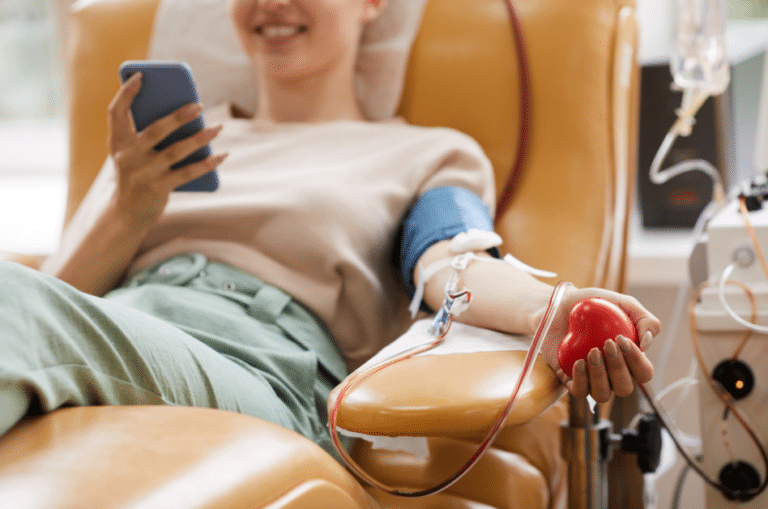
Donating blood is a simple, but much-needed way to help people with cancer. People with every type of cancer may need blood transfusions for any number of reasons during treatment. But human blood isn’t like medicines that can be created in a lab. The only way to get it is through donations from healthy donors.
Blood donors help ensure that a person with cancer has access to the life-saving care they need. It’s not just someone with cancer that might need a blood transfusion – donated blood is used in hospitals every day to help those with other health conditions, like sickle cell anemia, during surgery, and for burn victims.
People with cancer need 1/4 of the amount of the donated blood supply every year(1). Unfortunately, only 3% of the American public currently donates blood in any given year(1). Right now in the United States, we are experiencing the worst blood shortage in decades. Community members are urged to volunteer to give a life-saving blood donation. All blood types are needed, and would be put to good use. There are very strict laws about transporting blood across state lines, so it’s important to participate in a local blood drive, as you know your donation will help those in your own community.
For those who have never donated blood before, it’s important to know that the process is safe and easy. The staff at blood donation centers are trained health professionals who will guide you through the process and answer any questions you may have.
Donating blood takes only about an hour, and the actual donation process itself takes only a few minutes. By taking this small amount of time out of your day, you can make a big difference in someone else’s life.
What's the Purpose of Blood and What is it Made Of?
First, let’s talk about the importance of blood in our bodies. Imagine blood as a superhighway that carries essential nutrients and oxygen, etc. throughout the body. It also helps remove waste and toxins to keep you healthy. Blood is made up of different parts, and can be thought of as a team of superheroes, each with their own unique abilities.
- red blood cells are like delivery trucks, carrying oxygen to every part of the body.
- white blood cells are the defenders, fighting off invaders, like infections.
- platelets are the healers, rushing to the scene when there’s a cut to help the blood to clot and stop the bleeding, and
- plasma is the special liquid that carries all these cells around, getting these superheroes wherever they need to be.
Why Are Blood Products So Important to Cancer Patients?
Cancer treatment options like chemotherapy and radiation are designed to fight against and kill the cancer cells. While these treatments are powerful, they can also damage the healthy cells in the body, including those responsible for making blood. This can lead to a drop in the number of healthy blood cells. Here are the ways that blood transfusions (where donated blood is given to the patient via a needle into their vein) can help someone being treated for cancer:
- Chemotherapy can reduce the number of red blood cells in the body, leading to fatigue and difficulty breathing since the blood is not carrying normal amounts of oxygen. Red blood cell transfusion can boost energy levels and improve breathing, leading to an overall improvement in their quality of life.
- Chemotherapy and radiation also can decrease the platelets in blood. This makes is harder for the body to stop bleeding if there is a cut. For patients at risk of internal bleeding or severe bleeding, platelet transfusions from a platelet donation can literally save their lives.
- White blood cells can also drop as a result of different cancer treatments. Medicines can be given to stimulate the body into producing more white blood cells or transfusing donated white blood cells can help patients fight off infections.
- Plasma contains proteins, nutrients and clotting factors. Sometimes people with cancer develop a condition where their body cannot make their blood clot. Plasma transfusions are needed to help clot the blood.
When you donate blood, your donation doesn’t just replenish the blood supply of a person with cancer, it restores their strength, boosts their immunity, and helps their bodies fight against cancer.
A True Story of One Patient and His Need for Donated Blood
Here’s a story that will hopefully give you an idea of how much and how often someone battling cancer may need blood from a volunteer donor.
Seth is a bright, 8-year-old boy who was diagnosed with Acute Lymphoblastic Leukemia (ALL), a blood cancer, in 2018. During his lengthy treatment, which included radiation, dozens of rounds of chemotherapy and two bone marrow transplants, he needed more than 240 units of blood.
Thankfully, he’s now in remission, and we hope he’ll stay that way. But he relied on the selfless acts of 240 people to live. And this is just for one little guy – now multiply that by the almost 2 million new cancer diagnoses each year!
Not everyone with cancer will need blood or platelet or plasma transfusions, but it just goes to show how great the need is for platelet donors and whole-blood donation to try to address the crucial blood supply shortages.
Who can be a Blood Donor?
According to the American Red Cross, here are their current (as of August 2023) general requirements. Donors must be:
* Healthy adults
* at least 17 years of age (in some states, 16 year olds can donate with parental consent)
* weigh at least 110 pounds
* have adequate iron levels in your blood
* be in good health and feeling well the day of donation
There are some restrictions on donating that include, but are not limited to:
* taking specific medications
* have some diseases that can be transmitted by blood
* have certain blood diseases or blood disorders. If you’ve had a blood cancer, you will not be able to donate blood (but you can help in other ways, which I’ll talk about below)
* recent and/or prolonged travel to a country outside of the U.S. with a high malaria rate
Please contact your local center for their blood donation guidelines.
Donating blood has recently become more inclusive. The American Red Cross has removed eligibility criteria based on sexual orientation. Other eligibility criteria still need to be met before every donation, but there is no longer blanket exclusion for members of the LGBTQ+ community based on sexual orientation alone.
The Process of Donating Blood
Donating blood is a simple and straightforward process. Most of the time you’ll be in and out of your local blood donation center or mobile unit within an hour. Here’s a brief overview of what you can expect when you donate blood:
Registration and Health History
You’ll need to provide some basic contact information, show your ID, and complete a health history questionnaire. This helps ensure that you’re eligible to donate blood and that the donation will be safe for both you and the recipient.
Physical Exam
A brief physical exam to check temperature, blood pressure, pulse, and hemoglobin levels will be done to make sure you’re healthy enough to donate blood.
The Donation Process

The actual blood donation process only takes about 10 minutes on average. You’ll sit on a tall table that has an adjustable back or reclining chair so that you’re comfortable. You’ll extend your arm on an armrest and the trained technician will clean a section of your skin. Then they’ll insert a sterile needle into your arm and collect the blood into a special bag.
A standard whole single blood donation is about 1 pint, or 450 milliliters. A few vials of blood will also be collected to type and test the blood before it is able to be given to a recipient.
When the collection is complete, the technician will remove the needle and put a bandage on your arm.
Refreshment and Recovery
After donating blood, you’ll be given a snack and a drink to help you recover while you rest for a few minutes. This is to make sure you don’t get dizzy or feel sick when getting up from the donation chair.
It’s important to stay hydrated and avoid strenuous activity like lifting for the rest of the day to ensure a smooth recovery.
Tips to Remember
If it’s your first time donating blood, you may be a bit nervous and not know what to expect. Reviewing the donation process above can help prepare you for what to expect. On the day of donation, remember to:
- Stay Hydrated: Drink plenty of water before and after donating.
- Eat Well: A nutritious meal before donating can help prevent dizziness.
- Wear Comfortable Clothes: Opt for clothes with short sleeves or those that can be easily rolled up.
- Bring ID: A driver’s license or another form of identification will be required.
- Relax: The donation process is quick and easy – no need to stress!
Processing the Gift: What Happens to Donated Blood Before it Reaches a Patient?
After your generous donation, the collected blood undergoes a careful and important process to ensure it’s safe and effective for the patients who need it. Let’s dive into the behind-the-scenes journey of your donated blood before it reaches its destination:
1. Collection and Identification: Once you’ve donated blood, it’s carefully labeled with your unique donor identification number. This is to make sure that the right blood goes to the right patient, keeping everyone safe and preventing any mix-ups.
2. Testing for Safety: Before your donated blood can be used, it goes through a series of tests to ensure it’s free from any infections or infectious diseases. These tests include screening for diseases like HIV, hepatitis, and other infections that could potentially be transmitted through blood. If a test shows any concerns, the blood won’t be used for patients.
3. Separation of Components: Your blood is incredibly versatile! After the safety tests, it’s often separated into its different components – red blood cells, platelets, plasma, and sometimes even white blood cells. This allows hospitals to use specific components for specific patients, depending on their needs.
4. Storage and Preservation: The different blood components are stored at specific temperatures to keep them fresh and effective. Red blood cells are usually stored at colder temperatures, while platelets are kept at room temperature to maintain their function.
5. Inventory Management: Blood banks manage a delicate balance between supply and demand. They carefully track their inventory to ensure they have enough blood products available to meet the needs of patients without letting any go to waste.
6. Matching and Distribution: When a patient needs blood, the blood bank team carefully matches the patient’s blood type and specific requirements with the available blood products. This attention to detail ensures that the patient receives the right blood that’s compatible with their body.
7. Transport and Delivery: Once matched, the blood is transported to the hospital where the patient is being treated. This transportation is often done under strict temperature controls to maintain the quality of the blood components.
8. Life-Saving Treatment: Finally, the donated blood reaches the patient who needs it. Whether it’s a cancer patient, someone undergoing surgery, or an accident victim, your donation becomes a lifeline, providing the essential support needed for recovery and healing.
9. Monitoring and Follow-Up: After the blood has been transfused, medical professionals closely monitor the patient’s response to ensure there are no adverse reactions. This monitoring helps ensure that the patient benefits from the donation without any complications.
What If I'm not eligible to donate?
There are still ways that you can help, even if you are not eligible to donate for any reason:
- Share this blog post via social media
- Help organize a blood drive in your community
- Spread the word about upcoming blood drives
- Help a donor. If you know someone who wants to donate, but can’t find the time or needs childcare in order to donate, offer to watch their kids or drive them to the donation center.
- Volunteer for the donor center by sending out donation reminder emails or phone calls, or volunteer at the blood drive event and helping to hand out refreshments.
Now that you have a clearer picture of why different types of blood donations are so important to helping patients in their fight against cancer, the process of donating blood and what to expect, I hope you’ll consider contacting your local American Red Cross center or blood collection center and registering to become a donor. Maybe I’ll see you at my every-8-week appointment as I donate!
Frequently Asked Questions
You might feel a small pinch when the needle is inserted and/or removed, but most donors say it's painless.
I'm not a fan of needles, but I've found that if I look away while the needle is being inserted and I focus on breathing techniques, I'm just fine.
In most cases, you can donate whole blood every 8 weeks.
Your body replaces the donated blood quickly. After a snack and some rest, you'll feel just fine.
You should drink extra water after your donation and avoid heavy lifting or strenuous activities that day as well to let your body replenish your blood supply.
No - all equipment used is sterile and used only once for your donation.
No, not while you're in treatment. However, after your treatment has been over for about 12 months and you were not treated for a blood cancer, you may be able to donate. Check with your local American Red Cross or blood center.
It depends. If you've had blood cancers, including leukemia, lymphoma, or multiple myeloma, you will not be able to donate blood. Please share your stories with others along with this blog post to encourage others to donate to help other people with cancer.
If you've had another type of cancer, once you are about a year out from your treatment being completed. Check with your local blood donation center for their eligibility requirements.
Most cancer survivors are not able to donate plasma. You may be able to donate blood by apheresis, which is where you're hooked up to a machine to donate.
The machine collects and separates the different parts of your blood, so that the other non-plasma parts can be donated to those in need.
Check with your local center to see if that is an option for you.
Note that this type of blood donation typically takes about 2 hours.



